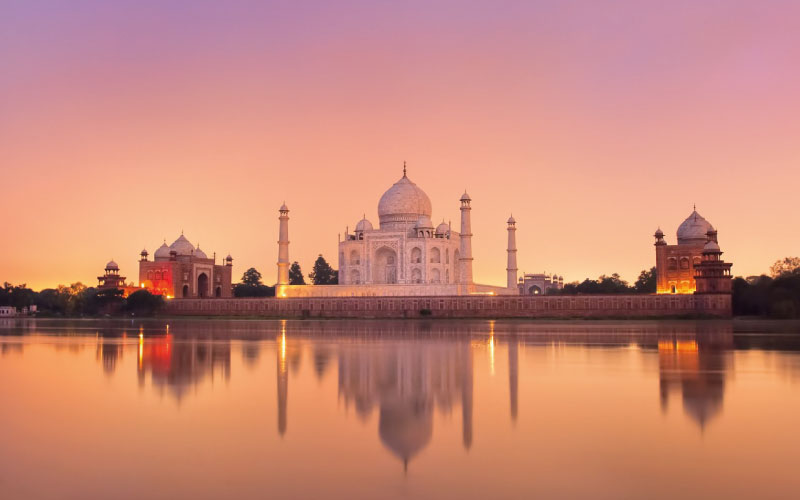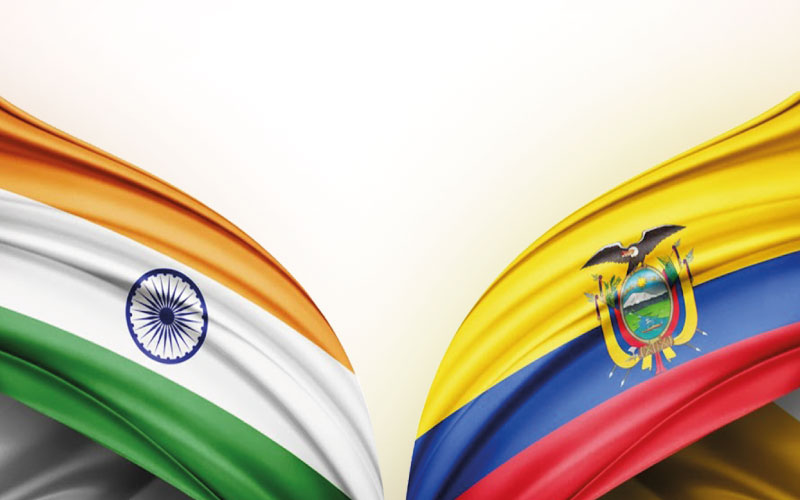The year 2025 is a promising one for India and Ecuador’s partnership.
The India Ecuador Chamber of Commerce (IECC) held an annual gathering of business owners in UEES, Guayaquil in October to continue forging strong commercial and cultural ties between the two countries. The IECC is a group of Indian and local business owners in Ecuador who facilitate networking, mentor young entrepreneurs and organise cultural events round the year to bring the two communities together. Ecuador also celebrated its 216th Independence anniversary and 56 years of diplomatic ties with India this year. H.E. Mr. Fernando Xavier Bucheli Vargas, Ambassador of Ecuador to India, was recently quoted in the Diplomatist Magazine, saying that his vision is ‘not only about political and economic cooperation, but about connecting hearts and cultures across the two continents.’
Despite diplomatic relations since 1969, the two countries receive little global attention, even though they share postcolonial values and common challenges.
Ironically, in spite of having diplomatic ties since 1969, India and Ecuador rarely appear together in foreign policy discourses because of limited media coverage and the international relations domain being heavily influenced by American, Chinese and European narratives. To outsiders, India and Ecuador look like two disconnected lands, situated far apart on the world map, having different languages and histories that have no ground of similarity. But the foundation of their friendship has been their postcolonial identities and sharing the same value systems on growing trade, battling terrorism, cyber threats, and bonding with each other socially and culturally.
Strategic Partners
Compared to India’s ties with Brazil or Mexico, the India–Ecuador relationship is modest in trade volume, but strategic in character. For India, Ecuador offers an attractive partner in Latin America. It has a democratic governance that is stabilising internal struggles, there are abundant natural resources here, biodiversity and agricultural potential. India’s presence counterweighs the Chinese influence in the region. Ecuador’s desire to diversify trade away from its traditional partners such as the United States, China, and the European Union also aligns with India’s “Act Latin America” policy, aimed at expanding its presence across Latin America.
India offers technology, educational opportunities, defense and space cooperation, innovation in renewable energy, access to cheap yet well-established pharmaceutical products and above all a large market demand to Ecuador. Vehicles, notably two-wheelers, pharmaceuticals, textiles, machinery (equipments and boilers) and chemicals are currently the major export commodities from India to Ecuador.
For Ecuador, crude oil has been the prime export commodity. Economic Times stated that the trade value between the two countries was at its peak in 2014-15 at $1.29 billion largely driven by oil exports from Ecuador to India. However, the global oil price swings were so volatile the following year that the trade plummeted down to $553 million. The fluctuating oil prices cooerced Ecuador to diversify its trade goods beyond oil, making Agriculture the next big commodity for export. Efforts are underway to brand and upgrade avocados, high-quality cacao and passion fruit to satisfy the high demand of exotic fruits and edibles in India’s growing middle class market. Other major exports from Ecuador to India are wood (teak and timber), pearls and precious stones, shrimps, coffee and spices.
Tourism is a huge source of wealth for Ecuador given its gorgeous landscapes and being home to the world famous archipelago, the Galapagos Islands, which played a significant role in the development of Charles Darwin’s theory of evolution. Diverse ecosystems and species that are found nowhere else on Earth, makes Galapagos Islands a living laboratory for scientists and a popular destination for nature lovers. Sadly, when tourists visit Latin America, they are able to travel across Peru, Colombia, Chile and neighbouring countries but unable to enter Ecuador due to stringent visa regulations. Making visa applications faster, online and easier with lesser documentations to go through is an easy step towards boosting Tourism.
On the contrary, it is harder to overcome geographical hurdles that makes shipping costs to soar and destroys perishable goods. Language barriers with Hindi, English and Spanish make it difficult for new Indian businesses keen on entering Ecuador, and vice versa.
Soft Power and Cultural Bridges
The longer I live in Ecuador, the more I am reminded of my home country. I realize that official diplomatic records often do not reflect the true nature of human connections. The way people greet each other on the street, the instinct to help total strangers, the resilience of street vendors who stand firm against bargaining customers while selling their wares, the widespread mistrust of politicians, and the determination to maintain dignity in the face of economic hardship—these are all shared human stories that transcend language and geography.
The Indian community in Ecuador is small but active, engaged in business sectors and local cultural celebrations.
The Indian diaspora in Ecuador is small, comprising around 300 people, most of whom are professionals or businesspeople connected to Indian-owned enterprises in sectors such as cocoa, timber, trade, or food. A common thread among them is the experience of migration, which involves blending into a new culture, learning Spanish, and adapting Indian habits to the Ecuadorian lifestyle. A vibrant community of Indians and Ecuadorians actively participates in major Indian and Ecuadorian festivals. Clad in beautiful Indian attire and ornaments, Ecuadorians dance alongside Indians during Navratri and Janmashtami to popular Bollywood songs, and they celebrate Diwali by bursting firecrackers. Conversely, Indians join their local friends in singing Christmas carols, proudly setting up Christmas trees in their homes in December, and burning monigotes (large paper-mâché dolls) on New Year’s Day. This tradition symbolizes leaving behind the negativities of the past year and welcoming new beginnings.
Indian children in Ecuador present the most fascinating example of successfully blended cultures as they converse in Hindi with their Indian peers in their native accent, speak English like Americans, and communicate in Spanish with Ecuadorian flair.
Indian spiritual organizations like ISKCON have a quiet but dedicated following here in Guayaquil, Quito and Cuenca. The Shiv Shakti temple in Cuenca is another attraction for devotees and tourists. International Yoga Day always pulls in a large crowd in different cities in Ecuador. The Sathya Sai Baba School in Bahia offers spiritual discourses, organizes spiritual retreats for students, and imparts education within a framework of life principles taught by the Indian saint Sathya Sai Baba.
Furthermore, there are occasional Indian film screenings at local theaters, concerts, craft exhibitions and temple ceremonies in Guayaquil, Cuenca, and Quito, attracting audiences interested in Hinduism.
Musically, Bollywood is the first gateway to Indian culture for many Ecuadorians and Indians sing and dance to spanish songs with equal vigour and enthusiasm. Recently, a popular dance institute in Quito had performed on Bollywood numbers and has a good following of students.“No entiendo las palabras, ¡pero la música me hace querer bailar!” (“I don’t understand the lyrics, but the music makes me want to dance!”), the Ecuadorians cheerfully say. Ecuadorian music styles such as bomba, marimba y salsa are very popular among Indians. The Ecuadorian salsa single such as Ana by Paola Plaza or Vitamina by Jombriel are very popular in social gatherings.
Food serves as another intimate connection among people across the globe, acting as a shared language of joy and belonging. In India, the intricate layering of spices found in dishes like biryani and masala chai reflects centuries of cultural exchange and tradition. In Ecuador, a beloved coastal dish called encebollado, a hearty fish stew made with yuca and pickled onions, provides comfort and brings people together. One Indian restaurant owner in Quito, who has lived there for two decades, shared, “We serve samosas (Indian potato-stuffed pastries) with chimichurri and seco de pollo with raita (yogurt seasoned with Indian spices) to give customers a taste of both cuisines.”
Food creates cultural connections through fusion dishes combining Indian and Ecuadorian flavors.

Education: Ecuadorian students have begun to look at Indian universities for affordable graduate education in medicine, engineering, and IT. India’s Indian Technical and Economic Cooperation (ITEC) program has offered scholarships to Ecuadorian professionals in fields like rural development and governance. There is growing interest in collaborative research in biotechnology, climate-resilient agriculture, and renewable energy, areas where India’s low-cost innovation model resonates with Ecuador’s development priorities. In addition, Ecuador has shown interest in Indian space technology, including small satellite design and launch cooperation, potentially via ISRO (Indian Space Research Organisation).
The road ahead
As an Indian journalist living and working in Ecuador, I have the rare opportunity to observe this partnership not only from the standpoint of diplomacy but from that of families, students, entrepreneurs and artists who contribute to the grand tapestry of friendship and growth. I see a role for universities and media in reshaping how people see this diplomatic relationship. Encouraging student exchanges, media coverage, social and cultural collaborations, expanding tourism and more business partnerships are the pathways to deepen this bond.
Aditi Raman Shridhar is an Indian journalist living in Ecuador with her family. Her articles focus on human-centered journalism, international relations and cross-cultural storytelling. She also teaches english courses through her platform English Made Easy.
Bibliography
- The Economic Times. “India, Ecuador Ink Protocol to Set Up JETCO.” Oct 2015.
- Trading Economics: https://tradingeconomics.com/india/imports/ecuador
- Interview of Mr Vargas: https://diplomatist.com/2025/07/25/i-wish-to-bring-ecuador-closer-to-india/
- India Today NE. “India and Ecuador Sign MoU to Enhance Cooperation in Medical Products Regulation.” Jan 2024.
- Ministry of External Affairs, India. India–Ecuador Bilateral Brief, 2024.
- The World Affair. “Ecuador and India Forge New Opportunities for Trade and Investment.” March 2025.
- https://dakshin.org.in/countries/details/ecuador




